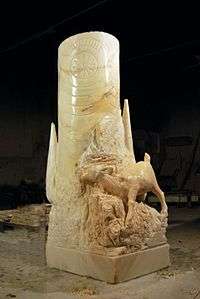Ataegina
Ataegina or Ataecina (Spanish; Portuguese: Atégina) was a popular goddess worshipped by the ancient Iberians, Lusitanians, and Celtiberians of the Iberian Peninsula.

Name and functions
The name Ataegina is most commonly derived from a Celtic source: the two roots *atte- and *geno- to mean "Reborn" or from *ad-akwī- (Irish adaig) meaning "night";[1] however her presence in decidedly non-Indo-European Iberian regions suggest that she may have an older, indigenous origin, in which case her name's etymology is more likely Iberian or Tartessian.[2] Epigraphs from the Badajoz region associate the goddess with the Roman Proserpina or Persephone which would make her a goddess presiding over Spring and seasonality, echoing the "reborn" derivation of the name.[3]
Ataegina was worshipped in Lusitania and Betica; there were also sanctuaries dedicated to Ataegina in Elvas (Portugal), and Mérida and Cáceres in Spain, along with other places, especially near the Guadiana river. She was one of the goddesses worshipped in Myrtilis (today's Mértola, Portugal), Pax Julia (Beja, Portugal) and especially the city of Turobriga, whose precise location is unknown. A bronze plaque from Malpartida de Cáceres suggests associations with the goat as a sacred animal.[3]
Dwarf planet
A team claiming to be the discoverers of the dwarf planet and plutoid Haumea, Ortiz et al., proposed Ataecina as the name of the body, due to her mythical connections with Pluto (Proserpina was the wife of Pluto), and her association with southern Spain, near to the discoverers' observatory. This proposal was not however accepted by the International Astronomical Union, not only because there is a dispute over whether Ortiz had actually discovered Haumea, but also because chthonic deities were reserved for bodies orbiting in stable resonance with Neptune, which was not the case for Haumea, whose weak 7:12 resonance was intermittent.[4][5]
References and bibliography
- E-Keltoi Journal of Inter-disciplinary Celtic Studies Vol. 6
- Lopes, Cristina Maria Grilo, Ataegina uma divindade Paleohispânica, Revista Santuários. - Lisboa, 2014
- Juan Manuel Abascal, Las inscripciones latinas de Santa Lucía del Trampal (Alcuéscar, Cáceres) y el culto de Ataecina en Hispania, Archivo Español de Arqueología 68: 31-105 (1995)
- Rachel Courtland (2008). "Controversial dwarf planet finally named 'Haumea'". NewScientistSpace. Archived from the original on 19 September 2008. Retrieved 2008-09-19.
- "Archived copy". Archived from the original on 2009-07-27. Retrieved 2008-09-22.CS1 maint: archived copy as title (link)
- Espírito Santo, Moisés. Origens Orientais da Religião Popular Portuguesa. Lisbon: Assírio & Alvim, 1988.
- Michael Jordan, Encyclopedia of Gods, Kyle Cathie Limited, 2002